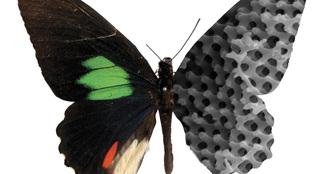 loading
loading
FindingsLocal color Photo illustration: Mark Zurolo ’01MFAView full image
The green patches on the tropical swallowtail Parides sesostris are no ordinary green. "Their color is structural," says ornithologist Richard Prum, "and it results from the interaction of light with these mind-bendingly weird structures in the wing cells called gyroids." Gyroids are complex shapes that resemble hollow, three-bladed boomerangs. Lattices of gyroids fill the swallowtail's wing cells, and most light flows into their openings. (The illustration above shows an image of such a lattice.) But light of certain wavelengths is scattered by these structures and reflected back to our eyes. Other butterflies, like monarchs, get their color from pigments. Lattices were long known to be the source of some butterflies' colors. Prum collaborated with Yale physicists and engineers to finally reveal their precise structure. By beaming X-rays through the wing scales, Prum explains, "you end up with a pattern of spots and dots. From this pattern we diagnosed that these nanoscale structures were gyroids." Because they control light so efficiently, gyroids could be valuable in fiber optic cables and other light-driven devices.
The comment period has expired.
|
|